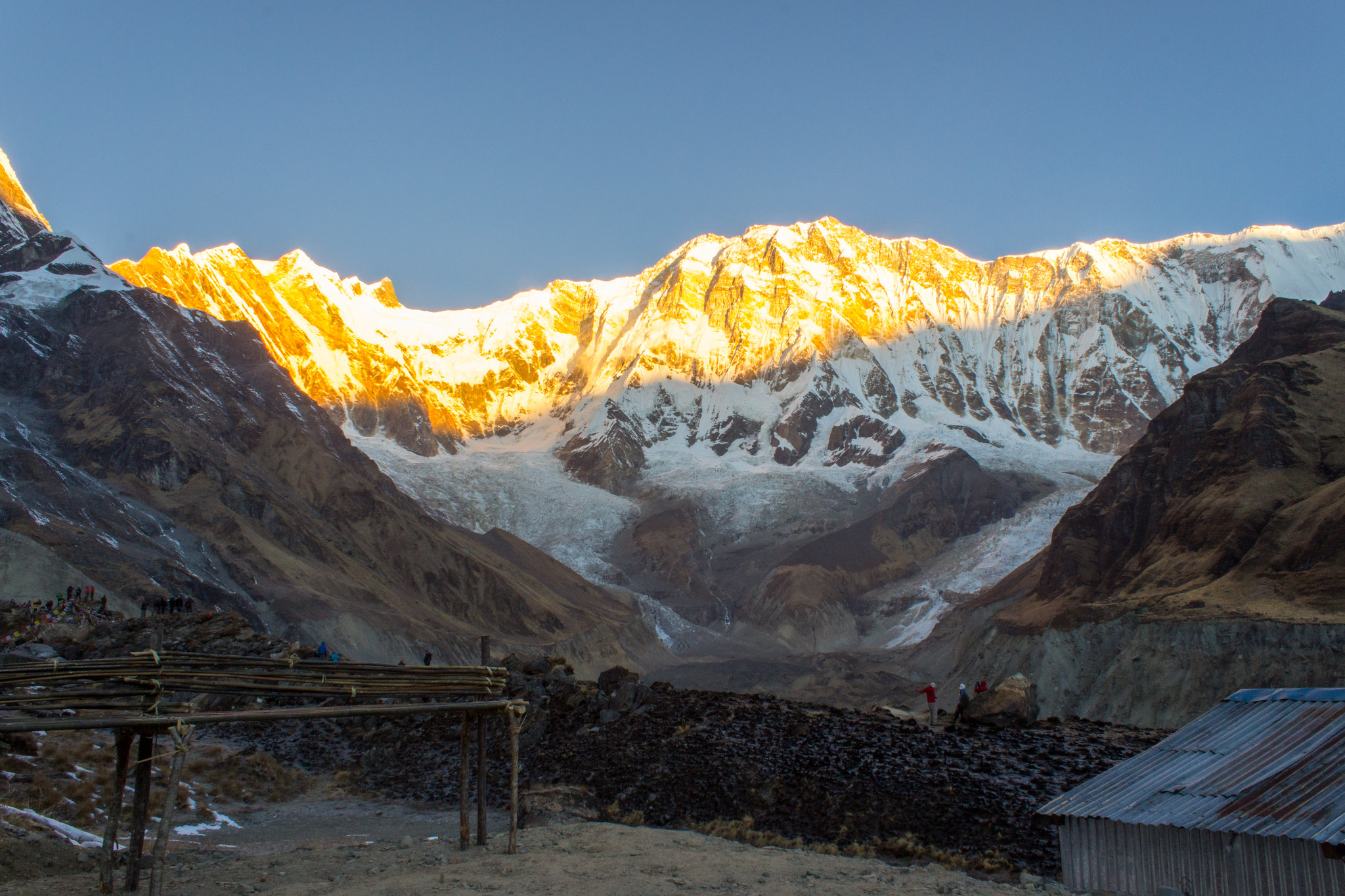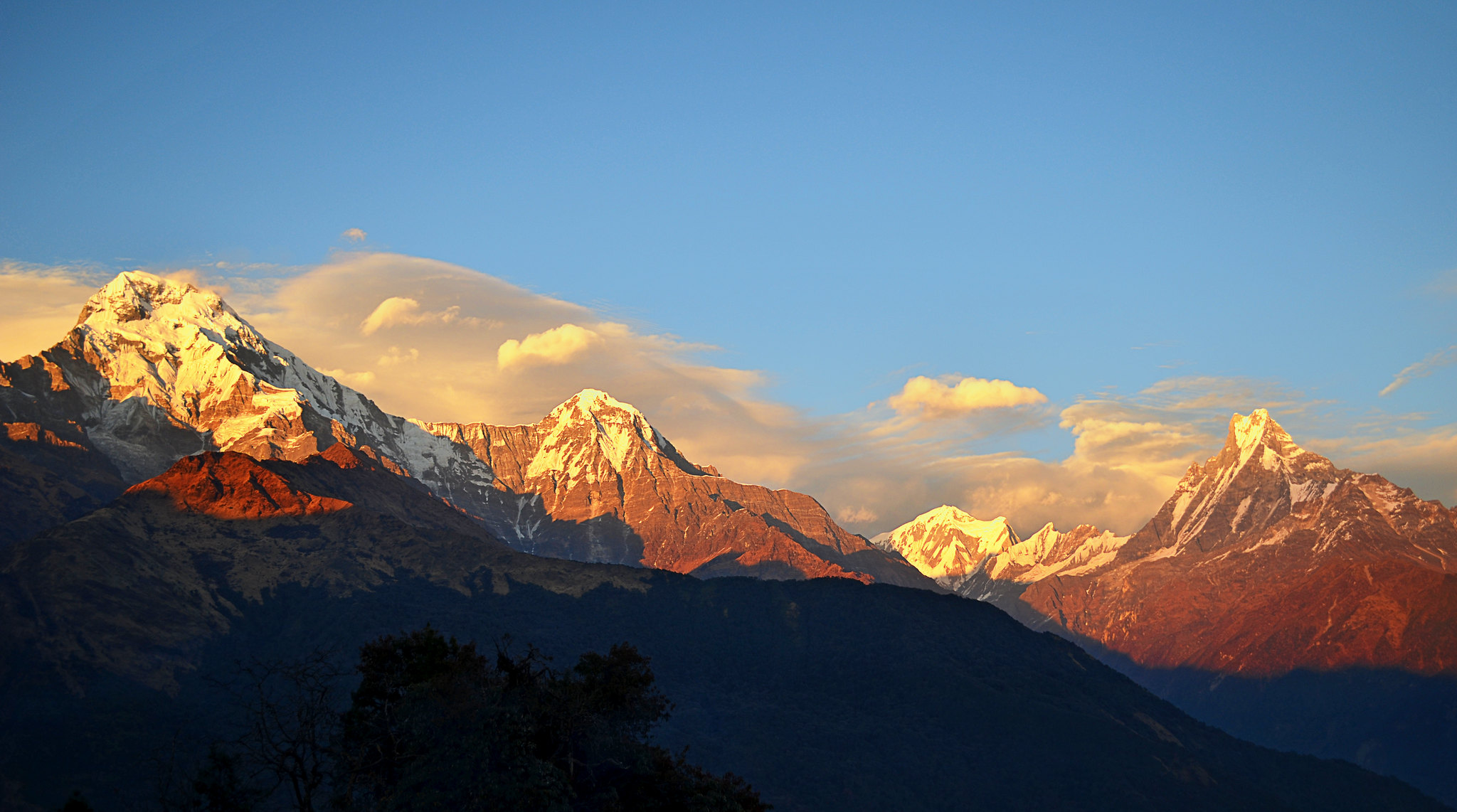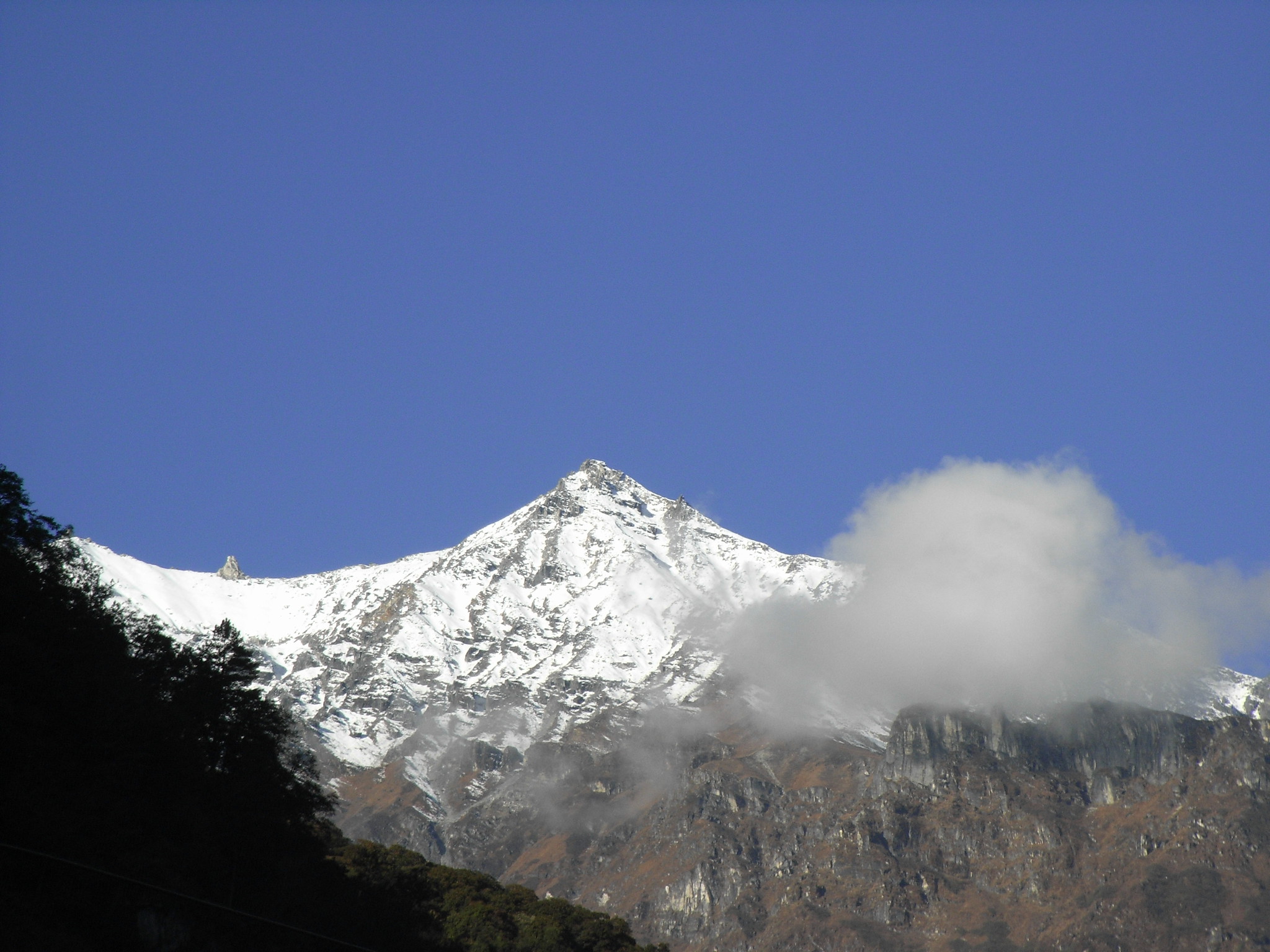Nepal, also known as the home of mountains has more than 1310 peaks above 6000m, comprising the world's eighth highest among ten. It supports astounding terrain rising from as low as 59 meters to the world’s highest peak Mt. Everest, 8,848 meters above sea level offering suitable habitations from tropical to alpine vegetation. Annapurna is a massif in the Himalayas in north-central Nepal. It includes one peak over 8,000 meters (26,000 ft), thirteen peaks over 7,000 meters (23,000 ft), and sixteen peaks more than 6,000 meters (20,000 ft). The massif is named after Annapurna, the Hindu goddess of food, nourishment and harvest.
Mt. Annapurna (8091m) of Nepal is the 10th highest mountain in the world and the journey to its base camp, which is at 4130m in height, is one of the most popular trekking destinations on earth. Protected by ACAP (Annapurna Conservation Area Project), sustainable tourism is in practice in this region. The conservation area covers the Manang, Mustang, Kaski, Myagdi, and Lamjung Districts. Annapurna Conservation Area encompasses Annapurna Sanctuary and is known for several trekking routes including Annapurna Circuit. This region offers varied landscapes and cultures of people. Cultural diversity and natural diversity are equally distributed in this area. The southern part of this region is dominated by Gurung and Magar whereas the northern part is by Thakali, Manangi, and Lobas. Covering an area of 7,629 sq. km., 100,000 residents of different cultural and linguistic groups dwell in this region.
The deciduous and deep forests of fir, pines, and birch are home to more than 100 species of mammals, 402 species of wild birds, and 35 species of reptilians. Rare wildlife species such as snow leopard, blue sheep, Himalayan black bear, and Himalayan Thar also are spread across the conservation area. Pisang, Manang, and Humde to the north of the Annapurna massif are a few of the famed specimens of Tibetan Buddhist settlements. Ghandruk, Ghorepani, Tadapani, and Mohare Danda are a few such examples. These settlements comprise Hindu and Buddhist followers and are acclaimed for offering charming hospitality to travellers.
Another major attraction of the Annapurna region is the Upper Mustang. Also known as the Forbidden Kingdom, Upper Mustang allows you to learn about the Tibetan-Buddhist heritage and history of the region. Monasteries in Thinggar, Namgyal, Niphu, and Garphu along with the mysterious sky caves add more mystery and allure to Upper Mustang. Annapurna region also hosts Tilicho Lake which is considered as the highest altitude freshwater lake in the world. Annapurna Circuit Trek, Ghorepani Poonhill Trek, Annapurna Base Camp Trek, and Upper Mustang Trek are a few of the famous treks in this region. From the world's deepest gorge, Kaligandaki Gorge to the largest rhododendron forest to the world’s highest altitude glacial Tilicho Lake, this region has it all.
Reasons to Trek to Annapurna Region
1) Exotic Flora and Fauna:
Annapurna Region has varied floras and faunas. Every step you take on your journey awaits surprise. Annapurna Conservation Area is rich in its biological diversity. About 1226 species of flowering plants including 40 orchids and 9 species of rhododendron – the national flower, also 101 mammals, 474 birds, 41 reptiles and 23 amphibians are found in this region. The southern region of Annapurna Conservation Area has abundant rhododendron forest while the northern part comprises alpine pastureland, and vegetation is diverse. It harbours rare and endangered wildlife species such as the snow leopard, musk deer, Tibetan argali, Impeyan Pheasant and Tragopan Pheasant. If you get lucky, you might spot a few of these.
2) Hot springs:
Another reason to trek to the Annapurna Region is the natural hot spring of Jhinu Danda. It is located on the bench of the Modi Khola. The pool is Surrounded by green trees, relax in the healing hot water and enjoy the glorious sight of the river. It is believed that taking a dip in a hot spring will cure your skin diseases and reduce stress because of the minerals present there.
3) Exploring culturally rich villages:
From the south to the north of the Annapurna region, people belonging to different ethnic groups have settled. From Gurung, and Magar to Thakali and Lobas, every settlement offers warm hospitality. One can explore the diverse culture of the Himalayas is an amazing experience one can ever get in their life. It genuinely changes the way you see your life for the rest of your life. So, the spiritual and pious sentiment is acquired in a variety of forms which is one of the major motives to trek in the Annapurna Region. You can learn about the local living style, culture, tradition, food and dresses along with helping the local economy to grow.
4) Easily Accessible:
Trekking trails befalling under the Annapurna region is the most beloved region amongst the trekkers. Trekking to the Annapurna region is easily accessible from Pokhara, which is just a seven-hour drive or half an hour away from Kathmandu Valley.
5) Mesmerizing Mountain View throughout the trek:
The most interesting part of the Annapurna Region trek is the changing scenery. You'll be left smitten by the gigantic white mountains which never leave your eyesight. Himchuli, Annapurna South, Barahi Shikhar, Annapurna I, Glacier Dom, Gangapurna, Annapurna III and Machhapuchhre, Dhaulagiri, Tarke Kang, Khangsha Kang can be seen from almost every region of Annapurna.
6) Moderate and suitable for any age group:
There are various treks to be done in this region. Every trekking route is suitable for any age group. From gentle trekking in the Annapurna Foothills, the trek into Annapurna Sanctuary, the classic Annapurna Circuit, the royal trek, and the mini–Annapurna Circuit, the Annapurna offers a wide range of treks of varying lengths, altitudes and grades. So, no prior experience of trekking is required to accomplish trekking in the Annapurna region.
7) The highest lake and deepest gorge
The Annapurna Region has some extraordinary natural features including freshwater lake at the highest altitude and the deepest gorge in Nepal. Tilicho Lake, at nearly 5,000m, is a stunning turquoise glacial body of water that makes for an exceptionally attractive and remote campsite and can be reached on the Nar-Phu & Annapurna circuit trek. The Kali Gandaki Gorge is not only the deepest in Nepal but one of the deepest on Earth. The descent into the Kali Gandaki is one of the places of interest of the Annapurna Circuit and is reached via crossing the famed Thorong La pass.
8) Walkthrough off-beaten tracks
Annapurna region not only offers you stone-paved paths but also has off-beaten tracks. You can trek to Nar Phu Valley, Khopra Ridge trek, and Annapurna Circuit are off the beaten tracks. The beauty of this trail is untouched and pure. This challenging trek takes you to the Tibetan border at the very edge of the Annapurna Conservation Area and combines the crossing of two high passes and time at dazzling Tilicho Lake with a journeying of infamous valleys and isolated communities set amidst stunning scenery and breathtaking landscapes.
9) Apple orchard
Trekking in the Annapurna Region in the autumn gives you a feeling of being in paradise. You will be very near to orchards full of trees heavily loaded with marvellously sweet apples – especially in Marpha the pretty apple capital of Nepal. Marpha’s apple pies have become world famous and their apple brandy too.
10) Tea houses and luxury lodges
The tea house is used mostly for accommodation in the Annapurna Region. Basic facilities include a twin bed, communal dining, and hot showers in a few places whereas, traditional teahouses include comfortable beds, healthy food and warm hospitality. For those looking to trek in more comfort, there are now several luxury trekking lodges in the foothills of the Annapurna.

Annapurna Region’s Key Attractions
- Enjoy a scenic drive from the capital of Nepal, Kathmandu to the beautiful lake city of Pokhara.
- Unveil the stunning beauty of Pokhara city and marvel at the mesmerizing Himalayan sights from there.
- Surround yourself with 360-degree magnificent towering peaks such as Annapurna, Machapuchare, Gangapurna, Dhaulagiri and many more.
- Marvel at the splendid sunrise view over the majestic Annapurna ranges from Poon Hill.
- Experience the warm hospitality and welcoming nature of Locals.
- Set your foot in the lap of the world's 10th-highest Mount Annapurna (8091m) base camp.
- Relax your body with the natural hot spring water in Jhinu Danda.
- Immerse yourself into the rich tapestry of cultures, traditions and lifestyles of locals.
- Enjoy a close-up stunning scenery of Mount Machhapuchre (6993m)
- Discover varieties of flora and fauna along the trail.
- Traverse through diverse landscapes, from lush rhododendron forests and terraced fields to alpine meadows, providing a kaleidoscope of natural beauty.
Popular trails in The Annapurna Region
1) Annapurna Base Camp
Annapurna Base Camp Trek is one of the most beautiful trekking packages in Nepal with loads of fun and adventure. This trek offers you with beautiful views of snow-capped mountains. The trek also puts together the exploration of many villages on the way along with their unique culture. It is a shorter and easier trek in comparison to other high-altitude treks.
2) Ghorepani Poon hill Trek
Ghorepani Poon Hill Trek is the most popular short trek to the Himalayas. In contrast to other short treks, Ghorepani Poon Hill Trek is truly unmatchable for the epic scenes it beholds. Similarly, the blend of Gurung culture also offers refreshing moments. The scenery on this trek is simply breathtaking. Poon Hill is the view tower at 3210m which offers a stunning view of the Himalayan panorama at sunrise with Annapurna I (8,091m), Annapurna South (7,219m), Dhaulagiri (8,167m), Lamjung Himal (6,983m), and Machhapuchhre (6,997m).
3) Mardi Himal Trek
Mardi Himal Trek is one of the most popular off-beaten trekking routes in the shadows of the Annapurna Himalayas. This trek is perfect for travellers looking for isolated trekking trails. The trail goes from one base camp to the other in a gradual manner while exploring the Annapurna Conservation Area. A diverse set of vegetation covers the entire trekking trails. These forests also shelter several wildlife species. The landscape changes quite abruptly into a rugged high mountain landscape, with amazing views of Mardi Himal, Machapuchre, Annapurna South and Hiunchuli.
4) Annapurna Circuit with Tilicho Lake
The Annapurna Circuit with Tilicho Trek encircles the Annapurna range. The trek combines many notable destinations in central Nepal. The trek is also a way to learn about the ancient culture and norms of the settlements on the trail. This route consists of the Highest pass Throng La, the Highest altitude lake Tilicho, the most preserved conservation area Annapurna, the sacred temple Muktinath, the most windy place Jomsom and many other attractions.
5) Ghalegaun Homestay Trek
Ghalegaun Homestay Trek is a short 7-day trek to a scenic village in Lamjung. The Ghalegaun is situated 12.5km to the northeast of Pokhara. It is an easy trek to learn about the Gurung ethnic group and their culture. Trekkers can also enjoy the scenery of the Annapurna range on the horizon. Get ready to immerse yourself in the beauty of the touristy village.
6) Panchase Trek
Panchase Trek is one of the best and most unique short trekking routes in the Annapurna Region. The name refers to the five seats of the mother in which a person experiences five levels of existence including thinking, feeling, sensing, and manifesting from above and below. From the Panchase viewpoint, you will see the giant Himalayan peaks of Machhapuchhre, Dhaulagiri, Annapurna, Lamjung, Gangapurna, and Manaslu. The forests in the Panchase area are very diverse, and much of it is classified as protected forest consisting of a large number of orchid species at over 100 and rhododendron forests.
7) Jomsom Muktinath Trek
Jomsom Muktinath Trek takes you to the foothills of the Annapurna Mountain Range and offers a wide range of scenic views, landscapes, and delightful cultural experiences. Along the route, trekkers get to enjoy the lush pine and rhododendron forest, pilgrimage sites and local culture of Gurung, Thakali, and Tibetan villages. This trek offers a sunrise view from Poon Hill over Annapurna Range and a chance to visit the Muktinath Temple.

Optimal Seasons for Trekking in the Annapurna Region
Mount Annapurna Trek offers an exciting high-altitude experience in the Annapurna region. Exploring any routes of the Annapurna region is available throughout the year, however, it sets out the best seasons: Spring and Autumn the months being March to May and September to December. During this time, travellers will get to enjoy clear skies, beautiful views, and favourable weather conditions, magnifying the overall experience.
However, during Summer, the onset of the monsoon season brings unforeseeable weather conditions whereas the wet and slippery trails raise challenges during Monsoon, the weather will be cold and the trail will be snowy which creates difficulties while ascending high terrain. While treks in Annapurna are still organized during this time, there is a possibility of flight cancellations or delays due to unfavourable weather conditions. Trek availability during these months is unexpected upon weather forecasts, with limited dates offered to alleviate risks.
It's important to consider the weather forecast while planning an Annapurna Trek, as it mainly affects the scheduling and feasibility of the expedition.

Challenging Trekking in the Annapurna Region
Annapurna Region trek presents a moderate challenge, making it achievable to a wide range of individuals without requiring an advanced level of physical fitness. However, the difficulty level depends upon the treks you embark on in the Annapurna Region. In comparison, the Annapurna Circuit with Tilicho Lake is more challenging than Annapurna Base Camp Trek, Ghorepani Poon Hill Trek, Ghalegaun Homestay Trek, Panchase Trek, and Jomsom Muktinath Trek. With adequate preparation and planning, any of the treks can be successful to conquer. No pr
Nature enthusiasts of all ages can relish the tranquil beauty along the trail, including families with children. Trekking to the Annapurna region includes gradual acclimatization to higher altitudes, assisting in adaption and guaranteeing a more amazing experience. Trek also contributes to overall physical wellness, as it involves aerobic walking in thinner air regions. Those with prior trekking experience and good physical condition can complete the journey in a relatively short time frame. If don’t have any experience in hiking also the success rate is high in this Annapurna trekking.
Crucial Documents Needed for ABC Trekking Adventure
Documents are the essentials to embark on any journey. You need to carry with you what might be needed at any point of the treks. Look out on the list to pack before undertaking any of the treks in the Annapurna region;
- Valid Original Passport – Needed for issuing ABC trekking Permit
- Travel insurance – To cover medical costs, flight cancellation or trip cancellation costs, and emergency rescue on a helicopter throughout the trip.
- Nepal Visa- On arrival, the visa is provided and should be valid during your trip to Nepal.
- Passport Size Photos -Bring 4 passport-sized photos needed for permits, SIM card and other reasons.
- Air tickets – Carry them with you for assurance of the trip.
- Nepali Cash and Credit Cards- Many places don’t accept credit cards or may get problems due to the high-altitude region.
- Map and Guidebook – If you are a solo traveller then, it is a must but we advise you to hire a professional guide to ensure safety and great experiences.
Permits and Costs for Annapurna Region Trekking

The Annapurna trekking zone is a restricted area in Nepal so an ACAP which is an (Annapurna Conservation Area Project Permit) and a TIMS (Trekkers’ Information Management System) card are essential to trek in the Annapurna region.
ACAP permits can be obtained from the Tourism Board of Nepal and also in Pokhara upon payment of USD 30 for individual trekkers.
TIMS Permits can be obtained in Kathmandu from the TAAN office or through the registered trekking agency. TIMS Permits cost 20 USD for individual trekkers.
If you are planning to do the Annapurna trek with any reputable company in Nepal, then all the permits and other required documents can be arranged by themselves. No need to worry about the documents for the trek.
Conclusions
Annapurna region trek offers a memorable journey through some of the most captivating landscapes in the world. From lush green forests to towering snow-capped peaks, this region exhibits the diversity and grandeur of the Himalayas. During the journey, travellers are rewarded with incredible views of renowned mountains like Annapurna, Dhaulagiri, and Machhapuchhre, as well as exploring diverse flora and fauna. The rich culture of the region is also noticeable while interacting with local villages and experiencing their unique traditions, and warm hospitality.
Moreover, the trek also bestows challenges, including high altitudes, remote terrain, and unforeseeable weather conditions. Sufficient physical fitness, essential gear, and attentive planning are crucial for a safe and enjoyable voyage.
Lastly, The Annapurna region trek is a once-in-a-lifetime adventure that amalgamates natural beauty, cultural absorption, and thrilling challenges. It's an experience that leaves an indelible impression and memories that will be cherished forever. Whether you're an experienced trekker or a novice adventurer, exploring the Annapurna region is sure to be an amazing experience for a lifetime






